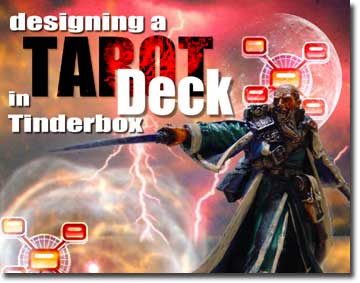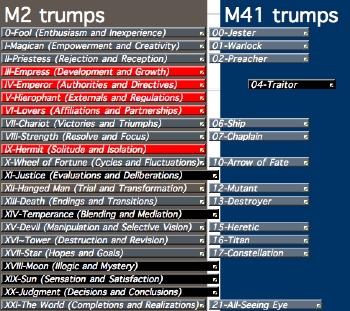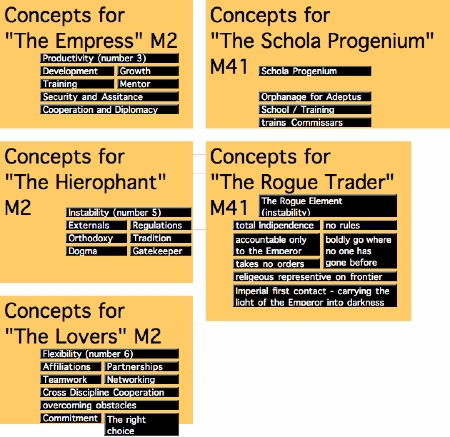Designing a Tarot deck in Tinderbox
2005-9-23
Tinderbox, Wargaming and the Tarot, three things that hardly seem related.
- Opener - what I'm doing and why you might care
- The challenge - mapping concepts
- The process - how Tinderbox helps
- step one - mapping the obvious
- step two - analyzing the remaining cards
- mapping new Concepts
- Outlook - what remains to be done
- re-shuffling the deck - are the choices appropriate?
- mapping and creating the suits
- narratively illustrate the cards
- further reading - if you want to know more

Opener - what I'm doing and why you might care
Tinderbox, Wargaming and the Tarot, three things that hardly seem related. In the following text I would like to show you how they became a very close knit for me, and the process I used. On the way you will learn about Tinderboy and how you could use it to map out tricky conceptual relations, a few things about the Tarot and it's underlying structures and maybe even one or two things about a fascinating Science Ficion setting.
I am using Tinderbox to design a fictional Tarot deck to be used in a very narrative oriented roleplaying game. Tinderbox' map view prooved invaluable in mapping out the concepts from traditional Tarot and creating corresponding cards that fit well into the setting and theme of the game.
The challenge - mapping concepts
There are numerous mentions of the Emperor's Tarot in the ever expanding series of novels set in the background. Those were valuable to get the 'feel' of the deck right, but gave very little info on the actual cards or their names, concepts, illustrations etc.
An official Emperor's Tarot was published in Games Workshop's magazine "White Dwarf" as a game supplement. It only names 29 cards, has almost no illustrations and very brief descriptions. It does lay out a basic structure for the deck, which is similar to contemporary Tarot. Starting from this info I decided to use the M2 Tarot as a basic layout to build the full M41 deck.
The challenge was to 'map' as many of the named cards from the previous M41 deck to equivalent M2 cards, to fill out the blanks and also try and be as true as possible to the theme of the Warhammer 40,000 background.
The process - how Tinderbox helps
This is where Eastgate's Tinderbox came in as a valuable tool. I used it extensively as a 'searchable notebook'. Collecting notes and quotes about Tarot, basic concepts and meanings of cards and what I could find about the Emperor's Tarot from various sources like novels, the previously published deck and also forum discussions. Tinderbox let's me organize textual notes any way I want and need to, enabling me to search this pile of notes in a quick and powefull interface.
Tinderbox' map views helped me map out textual concepts of various cards. I did this very much like I could have done on a whiteboard. The use of Tinderbox has the advantage of letting me re-structure and re-use the data as I see fit later on. Writing - and illustrating - this article is just one example of such a re-use.
step one - mapping the obvious
To get things rolling I decided to map out the obvious choices. I built a Tinderbox map with all the trumps of the M2 Tarot on one side in their proper order and all the named M41 trumps on the other. There are 23 trumps to a M2 Tarot deck, but only 13 trumps in the named M41 cards.
In my mapping below there are some very obvious correspondences like M2 "The Fool" and M41 "The Jester", but also some not so obvious and even some tendious ones.

step two - analyzing the remaining cards
Some of the remaining M2 trumps were basic concepts that are named directly: "Justice", "Temperance", "Judgement". I opted to simply use those without change. The not-yet mapped "Sun" and "Moon" M2 trumps could be copied directly. "The Star" had found it's M41 counterpart in "The Constellation".
I was able to match M41 "The Heretic" to M2 "The Devil", as the contemporative "Devil" is assosciated with "Manipulation and Selective Vision". "The Heretic" of M41 has very much of that. He is a man of faith - of misguided faith. And he is also a man of manipulation - a false missionary, using the truth in a very selective way.
mapping new Concepts
One important character/concept from the M41 universe has not been represented in the set of previously named cards: "The Rogue Trader" (The very first Warhammer 40,000 rulebook was called "Rogue Trader".)
A "Rogue Trader" is a free roaming agent of the Imperium, outfitted with the full authority and spiritual mission of the Imperium. He visits frontier worlds and uncarted space. His word is the word of the Imperium and he is accountable to no one but the Emperor himself.
Mapping out the concepts for M2 "The Lovers" I thought it could be well represented by "The Rogue Trader" in M41. A free or rogue trader needs a lot of the merrits "The Lovers" symbolizes: Cross-discipline cooperation, a flexible team, good networks and diplomscy. But "The Rogue Trader" also has aspects that do not fit "The Lovers": fierce Independance, owing account to no one.
So I tried the reversing concepts again. I found that it would be a far better match for the M2 "The Hierophant" if seen as an anathema. M2 "The Hierophant" stands for many of the things a M41 "Rogue Trader" is free of: Regulations, External Control, Orthodox Dogma. A "Rogue Trader" is also the frontline representive of the Imperial faith. A first-contact missionary with all the power and grants to represent imperial faith and law on new found frontier worlds. This fits well with "The Hierophant" which is also named "The High Priest" in some M2 decks.

M2 "The Empress" proved to be a suprisingly easy case. It's main concepts being Development, Growth, Nurishment, Training, Security and Assistance. One concept from M41 almost immediatly sprang to mind: "The Schola Progenium", an institution that nurishes, teaches and trains orphans of imperial officials. Many high ranking officers - even some inquisitors - come out of this orphanage, and look back on their mentors and teacher there.
Outlook - what remains to be done
In the space of this article I can only scratch at the surface of what I did - and still do with the design of this deck. The processes and the cards I described here are meant as an illustration of the basic process I used to solve some of the conceptual hurdles.
re-shuffling the deck - are the choices appropriate?
Once all cards have been suitably matched or created, I will need to re-evaluate the choices made. Ideally I will write out similar mappings for each card as I have described here.
mapping and creating the suits
One thing this article has not discussed at all are the "suits". A Tarot deck usually has four suits of 14 cards each. These are "Cups", "Coins / Pentacles", "Swords" and "Wands". The M41 named cards also have an equivalent, here called the "Four minor Arcana": "Adeptio", "Discordia", "Mandatio" and "Executeria". From the named cards of the pervious M41 work there are four cards/concepts arranged into each of these "minor Arcana", which could represent the King, Queen, Knight and Knave of each M2 Tarot suit. Contemporary Taror also has numbered suit cards (Ace to Ten) and the M41 deck most probably has those too, filling up the gaps towars the full 78.
The challenge now will be to get a rough match between the M2 and M41 "suits". Comparing the basic concepts shows that this will not be possible in all cases, as the concepts are spread up and mixed differently. Simply using the adapted meaning of all the M2 suit cards will not be possible. To design these M41 cards I will take the basic concept for each M41 "suit" and modify that by the cards position. For the named cards this would be the King/Queen/Knight/Knave positions and for the (not yet existing) numbered cards one based on the numerological modifiers.
narratively illustrate the cards
In their current form the cards in my M41 deck only exist as names and abstract concepts. I have mappings to the contemporary (M2) Tarot for some of the trump and suit cards. But I do not have appropriate illustrations to actually produce a physical deck of cards.
Looking at the descriptions of the fictional Emperor's Tarot, true physical hardcopies would not be possible with our technology. According to the writings these are "wafers of psi-active crystal" that show different pictures appropriate to the onlooker, the current situation and the questions asked.
As my plans for this project are to have a set of the "Emperor's Tarot" for use in textual narrative, an actual illustration for each card is not necessary. Far more important is a textual discription of the (possible) images and scenes each card might display. A "narrative illustration" of sorts.
Using the combination of real-world Tarot examples, the named concepts and my knowledge and feel for the M41 background I have started to write out such an illustration for each card. Going towards actual illustrations from those descriptions might be a fun project for an able illustrator or for myself should I suddently find myself with unlimited time and resources.
further reading - if you want to know more
- What is "Inqisitor" - an introduction to the Table Top game
- Downloadable "Inquisitor" Rulebook
- The authors weblog will have ongoing news on my work on the M41 Tarot deck and many other things.
- TarotTools.com - Mark McElroy's pages with articles and tips about using the Tarot in new and creative ways. Mark's book "Putting the Tarot to Work" was the basis of my structural analysis and early work with Tarot decks.
- Dealing Myself a Story - If you are wondering how a deck of (Tarot) cards might be used by a writer to creater a story please read "Dealing Myself a Story" by award winning author Bruce Holland Rogers
- The Black Libary - Publisher of all the Warhammer 40000 novels, comics and other stuff. They have a PDF exterpt of all the novels for download.
- UPDATE March 2011: time is our best friend... there are people who set out to create a complete (two actually) sets(s) of 78 cards with fan created artwork:
Similar
<< What is this? | Wolke 2: Der Lachende Gott der Traenen >>
alles Bild, Text und Tonmaterial ist © Martin Spernau, Verwendung und Reproduktion erfordert die Zustimmung des Authors